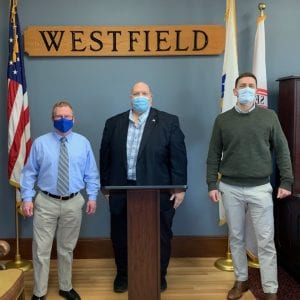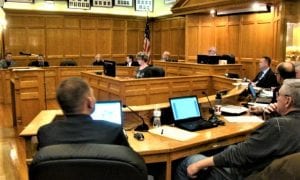WESTFIELD – The City Council voted Thursday to send a motion pertaining to road repairs to committee for further consideration. The council took that action after concerns were raised during discussion of the motion made by Ward 2 Councilor James E. Brown Jr.
Brown sponsored a motion to establish an ordinance to regulate how the pavement of city streets is cut and repaired by both city departments and private contractors. Currently road cuts are repaired with a patch the same size as the pavement cut. The proposed ordinance would require the department or contractor making the cut to obtain a city permit and to install curb-to-curb paving at least 10 feet beyond the edges of the pavement cut.
The motion was referred to the Legislative & Ordinance Committee and to the Law Department.
“How often do we pave a road and somebody has to make a cut, then throw in a patch that settles and destroys the road,” Brown said. “Other communities have this requirement. It’s something to get a little longer life out of our investment paving streets.”
At Large Councilor John J. Beltrandi III commended the intent of Brown’s proposal, but said that the problem of sinking patches is usually caused by improper back filling of the excavation.
“Compaction is the issue, not the patch,” Beltrandi said. “You can pave 20 feet around the cut, but if it’s not compacted properly, you’ll still end up with a hole in the middle of that pavement. What needs to be addressed is the compaction issue.”
At-large Councilor Gerald Tracy said that there is already an ordinance on the books.
“We should get what we pay for, but we’re not,” Tracy said.
At-Large Councilor David A. Flaherty suggested that a performance bond be added to the permit process.
Beltrandi, a contractor, said Friday that many area communities have a performance and inspection requirement as part of the permit.
“Most communities have a permit process which establishes guidelines and inspection requirements that put the contractor on the hook for between 30 and 60 days,” he said. “I just did a project in Agawam that required cut across the entire road. Compaction is done in 12-inch lifts to prevent settling and each step in the back fill process is inspected by the city before you can proceed.”
The compaction process may differ depending on the road and volume of traffic. Some communities require the use of “flowable” fill, a dense, dry concrete-like material delivered by a concrete truck.
“It does settle, but the density (of concrete) is there. It’s a more expensive option for compaction,” Beltrandi said. “Ninety percent of road patch failure are due to improper compaction.
“The other problem is that as the patch drops, it pulls the edge away from the pavement and allows water to infiltrate, which starts a whole different set of problems.”
Beltrandi said that the permit process is labor intensive for communities.
“You have to have someone issue the permit and someone to do the inspections at various stages of the project,” he said. “That requires manpower. Agawam and other communities have those people, but the Westfield Department of Public Works doesn’t have the people right now to do that.”







